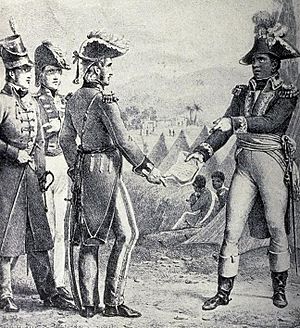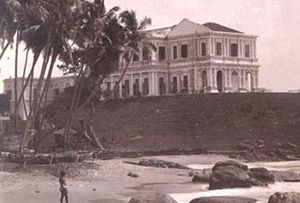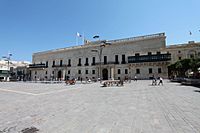Thomas Maitland (British Army officer) facts for kids
Quick facts for kids
Sir Thomas Maitland
GCB GCH
|
|
|---|---|

Portrait of Sir Thomas Maitland by John Hoppner, circa 1800
|
|
| 2nd Governor of British Ceylon | |
| In office 19 July 1805 – 19 March 1811 |
|
| Governor | George III |
| Preceded by | Frederick North |
| Succeeded by | John Wilson |
| 8th General Officer Commanding, Ceylon | |
| In office 1805–? |
|
| Preceded by | David Douglas Wemyss |
| Succeeded by | John Wilson |
| Governor of Malta | |
| In office 23 July 1813 – 17 January 1824 |
|
| Preceded by | Hildebrand Oakes (as Civil Commissioner) |
| Succeeded by | Francis Rawdon-Hastings |
| Lord High Commissioner of the Ionian Islands | |
| In office 1816–1823 |
|
| Preceded by | James Campbell of Inverneill |
| Succeeded by | Frederick Adam |
| Personal details | |
| Born | 10 March 1760 Scotland |
| Died | 17 January 1824 (aged 63) Malta |
| Awards | Knight Grand Cross of the Order of the Bath Knight Grand Cross of the Royal Guelphic Order |
| Military service | |
| Allegiance | United Kingdom |
| Branch/service | British Army |
| Rank | Lieutenant General |
| Unit | 62nd (Wiltshire) Regiment of Foot |
| Commands | General Officer Commanding, Ceylon |
| Battles/wars | Peninsular War Napoleonic Wars Haitian Revolution |
Sir Thomas Maitland (born March 10, 1760 – died January 17, 1824) was an important British soldier and governor. He held the rank of Lieutenant General. This means he was a very high-ranking officer in the British Army. He was also a Privy Councillor, which is a special advisor to the King or Queen.
Maitland served as a Member of Parliament for Haddington several times. He was the second son of the 7th Earl of Lauderdale. Sir Thomas Maitland never married.
Contents
Early Military Career
Thomas Maitland started his military career very young. He was officially made an officer in the Edinburgh Light Horse shortly after he was born. However, he didn't actually start serving until 1778.
He joined the 78th (Highland) Regiment of Foot as a captain. Later, in 1790, he moved to the 62nd Foot as a major. He continued to rise through the ranks, becoming a lieutenant-colonel in 1794. By 1798, he was promoted to colonel and brigadier-general.
Role in the Haitian Revolution

In 1797, Maitland arrived in Saint-Domingue, which was a French colony. His mission was to capture the colony for Britain. However, his soldiers quickly became very sick and many died from yellow fever.
Seeing this, Maitland decided to talk with the Haitian leader, Toussaint Louverture. They worked out a plan for the British to leave the island. This was a smart move because it saved many British lives.
On August 31, 1798, Maitland and Louverture made a secret agreement. Britain would stop attacking Saint-Domingue and would not get involved in its internal matters. Louverture promised the same regarding Jamaica. Also, British ships would allow supplies to reach Saint-Domingue's ports.
In May 1799, Maitland went back to Saint-Domingue. He wanted to make their agreement even stronger. On June 13, he and Louverture signed the Maitland Convention. This agreement allowed British and American ships to use the ports of Le Cap and Port-Républicain.
Governor of Ceylon

Sir Thomas Maitland was the Governor of Ceylon (which is now called Sri Lanka) from 1805 to 1811. While he was there, he really liked a place called "Galkissa" (now Mount Lavinia). He decided to build his official palace there.
There's a famous local story about Maitland and a young woman named Lovina. She was a dancer whose parents were from Portugal and Sri Lanka. The story says that while his palace was being built, Maitland had a secret tunnel made. This tunnel connected his palace's wine cellar to a well at Lovina's house nearby. He would use this tunnel to meet her often.
The village around the governor's mansion grew into a city. It was first called "Galkissa," but later it was renamed "Mount Lavinia" to honor Lovina. The tunnel was sealed up in 1920. In 2005, the Mount Lavinia Hotel celebrated its 200th birthday. Some of Sir Thomas Maitland's family from the UK even attended. Today, two roads in Colombo, Sri Lanka, are named after him: Maitland Crescent and Maitland Place.
Peninsular War Efforts
In early 1812, The 1st Earl of Wellington was fighting in Spain. He asked for help to stop French soldiers from coming from the east coast. Lord William Bentinck was supposed to send British troops from Sicily.
After some changes of mind, 8,000 men were put on ships under Maitland's command. They sailed to Menorca and picked up 6,000 Spanish troops. On July 31, they landed at Palamós, near Barcelona. Maitland decided that Barcelona was too strong to attack. He also chose not to try and capture Tarragona, which was not as well defended.
Maitland learned that another army, Joseph O'Donnell's, had been defeated. Without their support, Maitland felt he couldn't achieve anything. So, he took his troops back onto the ships and sailed to Alicante. There, his forces joined the local soldiers, forming an army of 15,000 men. The French army in the area was much larger, with 80,000 soldiers. Because of this, Maitland decided not to move from Alicante. He asked to be relieved from his command in September 1812 because he was ill.
Governor of Malta and Ionian Islands


In May 1813, Maitland became the Lieutenant-Governor of Portsmouth. Then, on July 23, he was appointed Governor of Malta. Malta became a British "crown colony" at this time, meaning it was directly ruled by Britain.
A serious plague had started in Malta in March 1813. It was spreading quickly, especially in Valletta and the Grand Harbour area. Maitland arrived on October 3, 1813, and officially took his job on October 5. He immediately put in place very strict rules to stop the disease from spreading. These rules included strict quarantine measures.
The plague reached Gozo by January, but by March 1814, the islands were free of the disease. Sadly, 4,486 people died, which was about 4% of the population. Many believe that without Maitland's strict actions, the outbreak would have been much worse.
After the plague was gone, Maitland made many changes. He removed British troops from Lampedusa in September 1814, ending a disagreement that had started in 1800. In Malta, he was a very strong leader. He didn't create an advisory group with Maltese representatives. Because of this, people sometimes called him "King Tom."
He started the Malta Police Force in 1814. He also made changes to taxes and the law courts. Maitland remained Governor until he died suddenly on January 17, 1824.
While he was Governor of Malta, Maitland also served as the Lord High Commissioner of the Ionian Islands from 1815 to 1823. These islands were a British protectorate. The main office was in Corfu. A beautiful Maitland Monument was built there in his honor in 1821.
Images for kids
-
Portrait of Sir Thomas Maitland by John Hoppner, circa 1800


